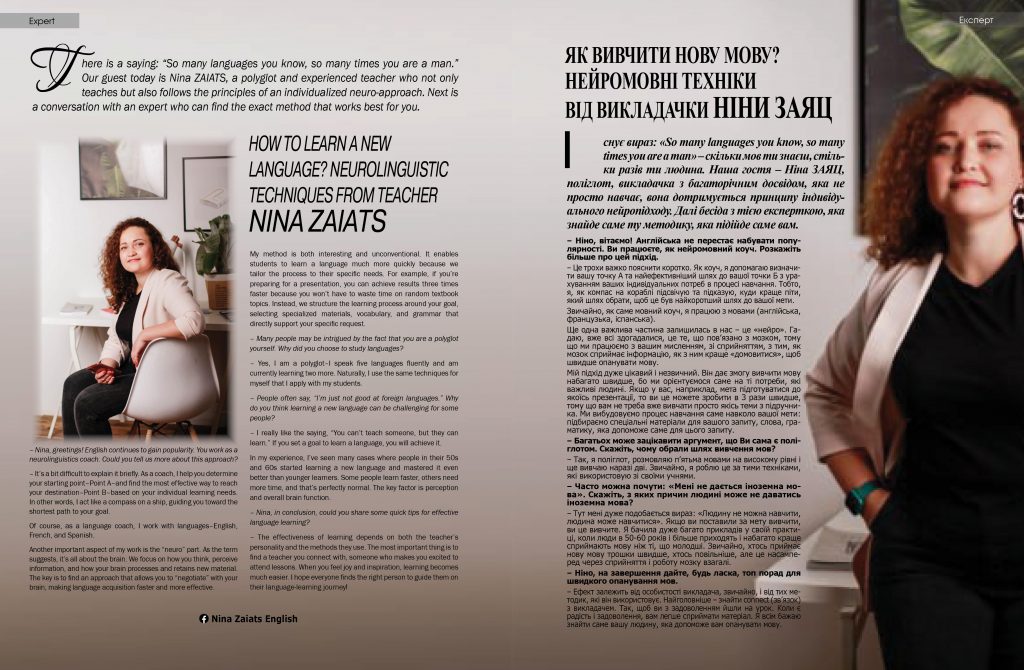Iснує вираз: «So many languages you know, so many times you are a man» – скільки мов ти знаєш, стільки разів ти людина. Наша гостя – Ніна ЗАЯЦ, поліглот, викладачка з багаторічним досвідом, яка не просто навчає, вона дотримується принципу індивідуального нейропідходу. Далі бесіда з тією експерткою, яка знайде саме ту методику, яка підійде саме вам.

– Ніно, вітаємо! Англійська не перестає набувати популярності. Ви працюєте, як нейромовний коуч. Розкажіть більше про цей підхід.
– Це трохи важко пояснити коротко. Як коуч, я допомагаю визначити вашу точку А та найефективніший шлях до вашої точки Б з урахуванням ваших індивідуальних потреб в процесі навчання. Тобто, я, як компас на кораблі підсвічую та підказую, куди краще піти, який шлях обрати, щоб це був найкоротший шлях до вашої мети.
Звичайно, як саме мовний коуч, я працюю з мовами (англійська, французька, іспанська).
Ще одна важлива частина залишилась в нас – це «нейро». Гадаю, вже всі здогадалися, це те, що пов’язано з мозком, тому що ми працюємо з вашим мисленням, зі сприйняттям, з тим, як мозок сприймає інформацію, як з ним краще «домовитися», щоб швидше опанувати мову.
Мій підхід дуже цікавий і незвичний. Він дає змогу вивчити мову набагато швидше, бо ми орієнтуємося саме на ті потреби, які важливі людині. Якщо у вас, наприклад, мета підготуватися до якоїсь презентації, то ви це можете зробити в 3 рази швидше, тому що вам не треба вже вивчати просто якісь теми з підручника. Ми вибудовуємо процес навчання саме навколо вашої мети: підбираємо спеціальні матеріали для вашого запиту, слова, граматику, яка допоможе саме для цього запиту.
– Багатьох може зацікавити аргумент, що Ви сама є поліглотом. Скажіть, чому обрали шлях вивчення мов?
– Так, я поліглот, розмовляю п’ятьма мовами на високому рівні і ще вивчаю наразі дві. Звичайно, я роблю це за тими техніками, які використовую зі своїми учнями.
– Часто можна почути: «Мені не дається іноземна мова». Скажіть, з яких причин людині може не даватись іноземна мова?
– Тут мені дуже подобається вираз: «Людину не можна навчити, людина може навчитися». Якщо ви поставили за мету вивчити, ви це вивчите. Я бачила дуже багато прикладів у своїй практиці, коли люди в 50-60 років і більше приходять і набагато краще сприймають мову ніж ті, що молодші. Звичайно, хтось приймає нову мову трошки швидше, хтось повільніше, але це насамперед через сприйняття і роботу мозку взагалі.
– Ніно, на завершення дайте, будь ласка, топ порад для швидкого опанування мов.
– Ефект залежить від особистості викладача, звичайно, і від тих методик, які він використовує. Найголовніше – знайти connect (зв’язок) з викладачем. Так, щоб ви з задоволенням йшли на урок. Коли є радість і задоволення, вам легше сприймати матеріал. Я всім бажаю знайти саме вашу людину, яка допоможе вам опанувати мову.
HOW TO LEARN A NEW LANGUAGE? NEUROLINGUISTIC TECHNIQUES FROM TEACHER NINA ZAIATS
There is a saying: “So many languages you know, so many times you are a man.” Our guest today is Nina ZAIATS, a polyglot and experienced teacher who not only teaches but also follows the principles of an individualized neuro-approach. Next is a conversation with an expert who can find the exact method that works best for you.
– Nina, greetings! English continues to gain popularity. You work as a neurolinguistics coach. Could you tell us more about this approach?
– It’s a bit difficult to explain it briefly. As a coach, I help you determine your starting point–Point A–and find the most effective way to reach your destination–Point B–based on your individual learning needs. In other words, I act like a compass on a ship, guiding you toward the shortest path to your goal.
Of course, as a language coach, I work with languages–English, French, and Spanish.
Another important aspect of my work is the “neuro” part. As the term suggests, it’s all about the brain. We focus on how you think, perceive information, and how your brain processes and retains new material. The key is to find an approach that allows you to “negotiate” with your brain, making language acquisition faster and more effective.
My method is both interesting and unconventional. It enables students to learn a language much more quickly because we tailor the process to their specific needs. For example, if you’re preparing for a presentation, you can achieve results three times faster because you won’t have to waste time on random textbook topics. Instead, we structure the learning process around your goal, selecting specialized materials, vocabulary, and grammar that directly support your specific request.
– Many people may be intrigued by the fact that you are a polyglot yourself. Why did you choose to study languages?
– Yes, I am a polyglot–I speak five languages fluently and am currently learning two more. Naturally, I use the same techniques for myself that I apply with my students.
– People often say, “I’m just not good at foreign languages.” Why do you think learning a new language can be challenging for some people?
– I really like the saying, “You can’t teach someone, but they can learn.” If you set a goal to learn a language, you will achieve it.
In my experience, I’ve seen many cases where people in their 50s and 60s started learning a new language and mastered it even better than younger learners. Some people learn faster, others need more time, and that’s perfectly normal. The key factor is perception and overall brain function.
– Nina, in conclusion, could you share some quick tips for effective language learning?
– The effectiveness of learning depends on both the teacher’s personality and the methods they use. The most important thing is to find a teacher you connect with, someone who makes you excited to attend lessons. When you feel joy and inspiration, learning becomes much easier. I hope everyone finds the right person to guide them on their language-learning journey!
